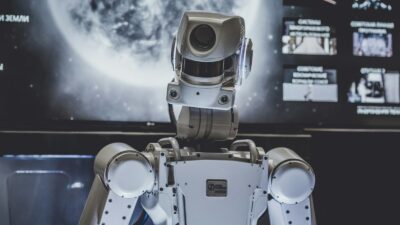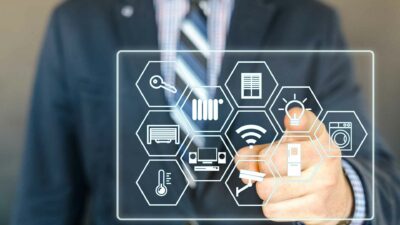Imagine you’re shopping online and notice an ad for that fancy new gadget you’ve had your eye on, for example, the Apple Vision Pro. You click the ad, but instead of taking you to the product page, the website greets you by name and displays not just the gadget, but two other products it predicts you’ll also be interested in, along with a personalized discount code. Pretty cool right? Well this is just one example of Machine Learning in action.
Table of Contents[Hide][Show]
From personalized shopping recommendations to predicting mechanical failures, machine learning has the potential to help transform multiple industries. But what is machine learning? And how is it creating real business value for organizations?
Definition & Key Methods Of Machine Learning
Machine learning refers to computer algorithms that can learn patterns from data and then use them to make predictions or decisions on their own. These machines can also get smarter. As the algorithms ingest more data, they are continuously improving and adapting, just like how human brains develop wisdom over time.
There are a few main methods of machine learning:
- Supervised Learning: In the(Amazon link) Sherlock Holmes novels (Amazon link), Holmes claims to be able to identify over 140 different types of tobacco ash. Throughout the series, he uses supervised learning to train Watson to also recognize the different types of ash. By providing Watson labeled ash samples from various brands along with the correct brand name, eventually Watson learned to accurately identify the brand of ash left at a crime scene based on visual appearance alone.
- Unsupervised Learning: In unsupervised learning, the computer algorithm isn’t given labeled examples to train on. Instead, it explores a giant mound of data to find hidden patterns or groups on its own. For example, an unsupervised algorithm could analyze customer purchase data to segment groups of people with similar buying habits.
- Semi-Supervised Learning: Semi-supervised learning combines a small labeled dataset with a large unlabeled dataset during training. It’s a pragmatic middle ground between supervised and unsupervised methods. Think of it as an explorer who has a vague treasure map with a few clues, but still needs to search a large area to find the big prize.
- Reinforcement Learning: With reinforcement learning, algorithms learn through trial-and-error interactions with an environment. The algorithm decides which actions to take in order to maximize some kind of cumulative reward. It’s similar to how we learn from positive and negative experiences in the real world. DeepMind’s AlphaGo program used reinforcement learning to teach itself master-level gameplay strategies by competing against itself over and over again.
What’s Driving Machine Learning Adoption
If you follow technology news, or are active in the stock market, then it probably feels like everybody is talking about machine learning right now. But machine learning isn’t new. Researchers first started using machine learning techniques back in the 1950s. Why is machine learning so popular now? There are a few reasons…
- Explosive growth in data volume, variety, and velocity. With smart devices everywhere capturing insights in real-time, we’re drowning in data. Machine learning provides a way to reveal patterns and meaning in massive data sets.
- Plummeting data storage and bandwidth costs. Storing insane amounts of data in the cloud is affordable for more companies. And high bandwidth networks allow rapid data transfer and analysis. With storage and bandwidth no longer cost-prohibitive, companies can now focus their budgets elsewhere, like AI data analysis.
- Vastly improved computational processing power. GPUs and massive processing environments allow complex machine learning algorithms to crunch data and find insights quickly.
Companies not only have massive pools of rich data to work with, but also the affordable, scalable compute resources to actually apply sophisticated analytical models. With profitable data insights more attainable than ever before, it’s no wonder machine learning adoption is exploding right now.
Concrete Examples of Machine Learning Business Value
Okay, we’ve covered the machine learning basics. Now let’s dig into some concrete examples of how this data analysis technology is creating value across a variety of industries:
Personalized Customer Engagement
Say hello to Sarah, a busy mom with two kids trying to keep her household running smoothly. After a hectic weekend spent carting kids to various activities, she’s relieved to finally sit down and browse for some new cookware that will make preparing quick family meals easier.
As Sarah navigates to her favorite home goods site (probably Amazon.com), she smiles to see a personalized homepage filled with cookware items similar to what she’s purchased in the past, along with some new products that the site predicts will also catch her interest based on her purchase history and browsing behavior. Feeling acknowledged and empowered by this tailored experience, Sarah eagerly dives into reviewing products, confident she’ll find items that perfectly suit her needs.
By combining customer profile data, purchase history, and browsing patterns, machine learning enables retailers like Sarah’s favorite shopping site to engage customers on an individual level. And these personalized, relevant experiences foster loyal, profitable long-term customer relationships.
The Next Best Offer
Here’s another scenario. Rocco, an avid hiker and outdoor enthusiast, decides to reward himself with some fancy new skis after completing a difficult mountain summit. As he’s entering payment info, the retail site displays a targeted 15% off coupon for a pair of ski poles that reviewers rave perfectly complement the skis. Though he hadn’t planned to buy poles today, the deal is too enticing for Rocco to pass up.
By predicting which additional products align well with Rocco’s purchase (a ski package), machine learning models help retailers provide the right supplementary offer at the right time to drive incremental revenue.
Preventive Maintenance
Machine learning also uncovers business value by using algorithms to discover anomalies for predictive maintenance operations. The models can identify concerning patterns or issues in real-time and alert businesses before an issue occurs. And preventing accidents can save lives.
Fraud Detection
Machine learning can also help identify fraudulent activity in real-time. By continuously analyzing massive volumes of transactions and customer data, advanced machine learning algorithms enable fintech companies to rapidly flag incidents of fraud.
Whether it’s detecting credit card scam transactions that seem inconsistent with a user’s purchase history, raising alerts when multiple account logins originate from distant locations in a short timeframe, or any other dubious activity, machine learning is leading the charge to identify financial crime as it happens to mitigate losses. With global cybercrime projected to continue rising, machine learning promises the sophisticated capabilities needed to keep ahead of criminal threats targeting our digital economy.
Differentiation From AI/Deep Learning

Now that we’ve mapped out what machine learning is and how it’s applied commercially, let’s distinguish it from the related domains of artificial intelligence and deep learning that companies also increasingly reference:
- Artificial intelligence (AI) is intelligence demonstrated by machines to simulate cognitive functions like problem-solving and learning. It’s essentially a broad concept, or a suitcase term, for any technology that enables computers to mimic human-level intelligence. Machine learning, on the other hand, is a specific subset within the field of AI focused on algorithms that can learn from data to make predictions, but don’t necessarily simulate broader human cognition. You can think of machine learning as a power tool in the AI toolkit.
- Deep Learning is a branch of machine learning based on neural networks modeled after the human brain. These deep neural networks can recognize really complex patterns within massive data sets by cascading input data through successive layers of processing. Deep learning models are exceptionally good at identifying patterns in unstructured data like images, video, and text. For example, Google Photos can use computer vision to “see” images and then deep learning to recognize specific people and objects.
The Future Of Machine Learning

As field of machine learning continues to make incredible technological advances, we need to carefully watch its impact on our society. How can we promote transparency and accountability? Mitigate bias in data or algorithms? And support those disadvantaged by automation?
At the same time, machine learning has lots of potential to change lives for the better – like predicting illnesses earlier, further democratizing information access, or growing food more efficiently. There’s a lot to be excited about!
What is machine learning? Learn how #machinelearning works and how it's related to AI and deep learning! #ML #deeplearning #AI Share on X





















 From Forests to Fish: How Acid Rain Devastates Our Environment
From Forests to Fish: How Acid Rain Devastates Our Environment
Leave a Reply